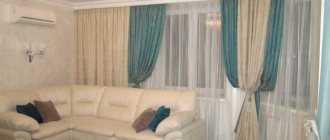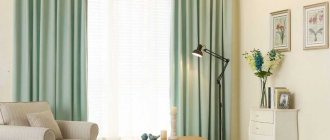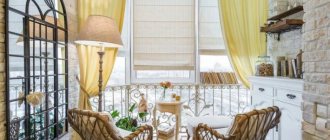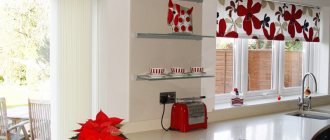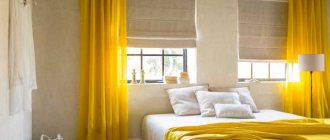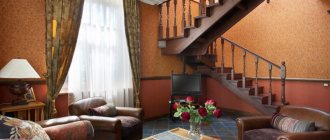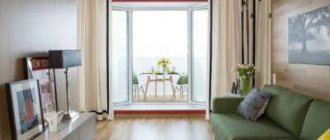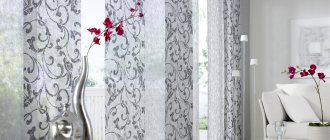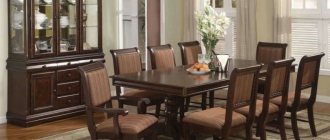Photo: zen.yandex.ru Bright sunlight looks amazing, but everything has its limit. Even in a welcoming living room, too much sun can sometimes cause discomfort. Therefore, do not rush to decisively abandon curtains, even if you are the happy owner of a luxurious panoramic view. Moreover, beautiful and well-chosen textiles are an amazing accessory for creating an atmosphere of home warmth and comfort!
Traditional living room
The classic style initially presupposes the presence of luxury and wealth in the interior, so products made from dense and expensive textiles: satin, velvet, brocade and jacquard will become an indispensable attribute of the living room.
Fabrics with patterns are suitable for walls with a monochromatic color, and for textured wallpaper or silk-screen printing, a plain fabric would be the right solution.
Curtains
Light and harmonious curtains consist of tulle, organza or veil, which allows you to play with design ideas. Such curtains can be plain or patterned, colored or plain.
Curtains cover the room from excess light, serve as protection from prying eyes and embody a feeling of comfort in the room. The main feature of curtains is lightness, so color shades must be gentle or pastel.
When choosing any curtains, it is important to consider: the method of care and proper washing, whether the curtains let in bright light and fresh air, and whether the fabric will fade over time.
Provence in the living room
This direction is distinguished by romantic notes in the design, so in order for the curtains to fully match the interior, it is preferable to choose a material in pastel colors.
- For example, lavender, mint or cream.
- French curtains, lambrequins and openwork curtains are almost ideal for this purpose.
- It is advisable to maintain all this romantic splendor in harmony with the color of the walls and upholstery.
Village in the city
Natural or rustic motifs can always be traced in a “country” interior. Accordingly, embroidery, checkered patterns and various floral patterns are quite acceptable for curtains in the living room.
The material is usually used with a rough texture: It can be burlap, matting or canvas.
Ruffles and various crocheted decorative elements are suitable as decorations.
Styles
Modern style
Originality and uniqueness are characteristic of custom-made curtains in a modern style. Curtains in natural tones will help refresh the room. Curtains made using modern technologies will appeal to lovers of this style.
Classic
Classic styles are characterized by the following fabrics: velvet, silk, cotton. Such curtains will look luxurious. The design composition directly influences the selection of the color of the curtains or pattern on the canvas. There are different options for mounting on the cornice.
Provence
French aristocrats discovered this style direction. It is characterized by rococo or classicism with an admixture of rustic motifs. Curtains for this style are light and unpretentious. The favorites among fabrics of this type are cotton fabric, linen, chintz, muslin and cambric. The fabrics should not be heavy, but can be dense.
High tech
It involves a combination of contrasting shades, for example, curtains, half made in black and white. As a rule, such curtains are sewn to order. Electric curtain rods, which can be lifting and sliding for this type of curtain, are not uncommon.
Minimalism
Such curtains include blinds, Japanese and Roman fabrics. The absence of bright colors will be a sign of minimalism. Bamboo, flax or wicker are usually used to make them.
Chalet decoration
The interior of the living room of a hunting lodge is chalet style. The fireplace area is, as a rule, an accent area, and the rest of the composition is built around it.
- Decorative elements include deer antlers and heads of wild animals on the walls, and most often bear skins on the floor.
- Whether they are real or not is not important, but in any case, velor curtains in the interior are what is required.
- Canvases made of plain fabric, dark gray or brown are suitable.
Color solutions
Modern interiors gravitate towards simple basic colors - white, black, gray and beige. Of the bright colors, deep natural shades are used - berry, beetroot, emerald, sapphire. Patterns, prints and ornaments are almost never used, so the best decoration is simply high-quality fabric.
French curtains
When decorating a room in a classic style, French curtains are most often used. They look like a cascade of wavy frills made of expensive shiny fabric. Such decoration, and there is no other way to call it, can be seen in theaters, museums or palaces.
Austrian curtains
A whole canvas with sewn cords is called an Austrian curtain. The principle of operation is as follows: when lifted, the cords tighten the material.
- Thus, folds are formed in the lower part, reminiscent of garlands - the so-called festoons.
- Almost any material is suitable for sewing, so fitting Austrian curtains into any interior will not be difficult.
English curtains
Analogue of Austrian curtains. They differ in that the canvas is attached to only two tapes with an indentation from the edges (as a rule, it is about fifteen centimeters), and when lifted, a smooth arc is formed in the center of the window.
Japanese curtains
The Land of the Rising Sun has its own view on such an important attribute of the interior.
But it’s quite difficult to call this design curtains.
- This is a canvas stretched over a rigid frame. The structure is inserted into the window opening.
- The canvas slides along guides fixed at the top, or at the top and bottom of the window - this is reminiscent of sliding cabinet doors.
Kiseya
Despite the fact that thread curtains are no longer a new product, they still do not go out of fashion and remain one of the most popular. Largely due to the fact that their choice is huge: modest and elaborate, plain and colored, consisting only of twisted chenille threads and containing inclusions of beads and rhinestones, with lurex and rainbow ones.
There are also natural types of muslin, for example, made from bamboo or linen fiber or cotton, but they are used mainly for living rooms in eco- or ethnic styles. In contrast, synthetic thread curtains can be selected to suit any interior. Many people mistakenly believe that such ephemeral curtains are not capable of shading a room. In fact, they do an excellent job with all the functions assigned to ordinary curtains, and, if necessary, they combine perfectly with curtains or tulle. And the unusual through texture of muslin allows you to use it not only to decorate window openings in a stylish and original way, but also to intelligently divide the room into functional zones.
It is impossible to list all the ways to decorate windows with muslin curtains, so we will consider only the most interesting of those that designers are offering us this season.
Snow-white and black muslin are still in demand. The first gives the interior a naive airiness, fills it with light and visually expands the walls. The second is suitable for strict high-tech interiors with an abundance of chrome parts (cornices, lamps, legs of tables and chairs). And if you want to maintain a balance between the first and second, combine both types on the windows, hanging them in two layers.
Cheerful multi-colored thread curtains are also appropriate in a modern living room. This can be either an alternation of color stripes, or a mixed multi-layer version, when another color shines through the threads of one shade. Multi-layering will look clearer if each layer is made of different lengths.
It is worth paying attention to combinations of thread curtains of various densities and textures. By draping them with the help of pins and tiebacks in the form of wavy structures or strict columns, you can create unusually stylish and original curtain compositions.
Since practicality and conciseness come to the fore this season, it is recommended to use muslin with non-woven inclusions in very measured doses. The ideal option is rare, transparent or beads that match the color of the threads.
Mounting methods
They are not particularly diverse. As a rule, this is a cornice, which is a horizontal crossbar.
- Most often, this is a pipe, and curtains move along it - loops, all kinds of clips or eyelet rings are sewn into the canvas.
- The last option is the most convenient, but the metal eyelets rattle quite a lot when sliding, so it is still advisable to purchase their wooden or plastic counterparts.
- The cornice also has a decorative value, which means you need to choose it taking into account the style and overall interior of the room.
If you plan to install non-sliding curtains, then they are hung directly on the cornice itself, and all kinds of tiebacks are used to fix the folds: these can be thin ribbons, ropes, cords - in general, anything that is suitable for these purposes and will look organic in the interior.
Choosing a cornice
When buying a cornice, take into account the load that thick transparent night curtains will carry on it. It must be strong and reliable enough to support the structure.
Convenience and ease of use are no less important - the curtain fastening elements should slide freely and unhindered along the cornice. Aluminum structures are considered the most durable, the additional advantage of which is their affordable price.
Wooden curtain rods are more expensive, but they are often preferred for aesthetic reasons. They go perfectly with the natural surfaces of the furniture set and are ideal for rooms decorated in warm colors - for example, they will be the ideal frame for curtains for a beige living room.
Definitely do not choose plastic designs for heavy night curtains - they are unlikely to withstand the weight of the fabric, and fasteners that deform under the weight of the fabric will cause a lot of inconvenience when moving the curtains.
For a small living room
The biggest problem when choosing curtains is the small area of the room. To minimize it, it is worth remembering several principles for selecting textiles.
- In spacious rooms, a large cage and a variety of patterns will suit the court, as they say. In living rooms with a small area, all these delights are more than inappropriate. It is worth paying attention to Japanese or Roman blinds: they are presented in a very wide range.
- In small rooms, it is advisable to use curtains to cover the entire wall with the window opening, rather than dividing it into parts. If the width of the fabric does not allow this, then the color of the fabric should match the color of the walls, and not contrast with it.
- When low ceilings are a bonus to a small room area, this problem is solved as follows: the cornice should be fixed to the ceiling or put it in a pre-prepared niche. All that remains is to disguise it with stucco or border to match the color of the ceiling.
- French, Austrian or English curtains are completely unsuitable for small living rooms. Simple ceiling-to-floor canvases will look more organic, perhaps with small vertical folds: they will visually increase the height of the ceiling.
A well-chosen fabric color is the key to successful window design. Matching the shade of patterns on the wallpaper or upholstery, it will always help the room look impressive, no matter what style it is decorated in.
In the case of a monochromatic wall color, it is advisable to choose a material with a small and unobtrusive pattern; as an addition, sew a tablecloth or bedspread from the same fabric.
Considering, if possible, all the listed subtleties, the living room can easily be turned into a place filled with comfort. It will be possible to comfortably spend your free time with your family and chat with friends.
High tech
For high-tech lovers, it is best to use different types - curtains and blinds, pleated blinds, Roman blinds and Japanese panels.
